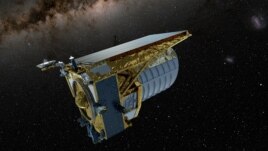12 November 2023
European astronomers released the first images from the new Euclid space telescope last week.
The European Space Agency (ESA) and the U.S. space agency, NASA, designed Euclid to study dark matter and dark energy. Scientists think those hidden forms of matter and energy make up 95 percent of the universe.
ESA is leading the six-year mission with NASA as a partner. ESA said the images were the most detailed of their kind. They show the telescope's ability to observe billions of galaxies up to 10 billion light years away.

An artist's concept shows the Euclid space telescope, built by the European Space Agency (ESA) in operation, in this undated handout image. (European Space Agency (ESA)/Handout via REUTERS )
The images covered four areas of the sky. They include 1,000 galaxies belonging to the Perseus cluster of galaxies 240 million light years away. In the background, the image shows more than 100,000 galaxies, ESA said.
The cluster is called the Perseus cluster because it appears in the star group, or constellation, Perseus.
Scientists believe such large structures like the Perseus cluster could only have formed if dark matter exists.
ESA's science director Carole Mundell said, "We think we understand only 5 percent of the universe: that's the matter that we can see."
"The rest of the universe we call dark," she continued, "because it doesn't produce light...But we know its effect because we see the effect on visible matter."
One sign of dark matter's hidden force is that galaxies rotate more quickly than scientists expect.
Mundell said it seems to have the effect of pulling together some of the largest structures in the universe, like groups of galaxies.
Dark energy is a new mystery
In the 1990s, scientists largely established the existence of dark matter after studying exploding stars called supernovas. That work resulted in a 2011 Nobel Prize shared between three U.S.-born scientists.
Looking at images from the earlier Hubble Space Telescope, scientists came to believe that the universe was not only expanding but that it was expanding faster and faster. That surprising discovery relied on a new concept: dark energy.
A new galaxy map
Euclid has been in a period of testing since its launch. Now it will start taking the images to make a 3D, or three-dimensional, map covering about a third of the sky. Scientists will use that map to look for small differences caused by the dark universe. Scientists hope the new understanding of dark energy and matter will help us learn about how galaxies formed, and why they are found across the universe.
Mundell said, "The purpose of the Euclid mission is really to start to probe that dark sector of the universe in ways that we've been unable to presently with current ground and space missions."
She added that the Perseus cluster is a good example of this huge gathering of mass. "We think there's lots of dark matter in that cluster and pulling these galaxies together."
A SpaceX Falcon 9 rocket launched Euclid from Florida in July.
The mission is expected to last six years. However, ESA hopes that Euclid will continue another six months if there is enough fuel to keep it in orbit around the sun. Euclid is orbiting the sun about 1.5 million kilometers away from Earth at "Lagrange Point Two," or L2. That is a place where the gravity of the sun, moon and Earth are balanced. A spacecraft can stay there, using less fuel. NASA's James Webb Space Telescope is also at L2, but it is not in danger of crashing into Euclid.
Other images released by ESA included an unusual galaxy with no exact form. Another was a spiral galaxy, sometimes called the "Hidden Galaxy," which looks much like our home galaxy, the Milky Way.
Speaking of the Perseus cluster, Mundell said, "You'll also see lots of background galaxies there as well, which is phenomenal. I think I spotted a new one there last night."
I'm Jill Robbins.
This story was reported by Tim Hepher and Steve Gorman for Reuters. Jill Robbins adapted it for Learning English.
______________________________________________
Words in This Story
galaxy – n. a very large group of stars and planets that extends over many billions of light years
light year – n. the distance that light travels in one year; 9.46 trillion kilometers
cluster – n. a group of objects gathered close together
rotate – v. to turn with a circular movement
probe – v. to ask questions or try to discover facts about something
sector – n. a part of something or area
spiral – adj. a shape that winds around and around, with each curve above or outside the previous one
phenomenal – adj. unusually great or good